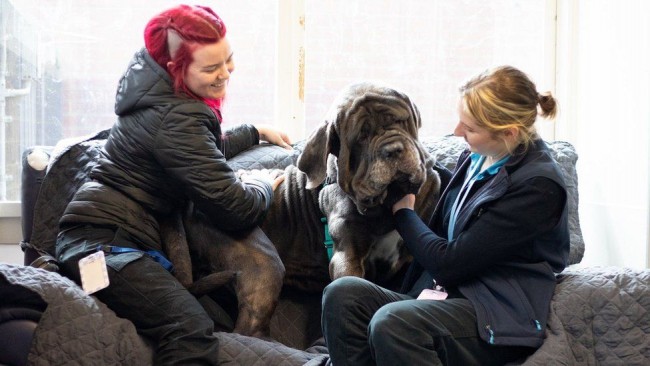
“It’s quite a sad day when people have to make a choice of either feeding their animals or their children. For some people, sadly, it has got to that situation.”
Susan Talevski knows this well. Her Lost Dogs’ Home animal shelter in Melbourne, Australia looks after hundreds of domestic animals – and their numbers are growing by the day.
One of the shelter’s newest guests is four-year-old Charcoal, a 63kg Neapolitan mastiff. He was given up by his owners who said they could no longer afford a pet.
And they are not alone in their struggles.
The cost of living has soared around the world as the effects of the pandemic and the Ukraine war push up the price of food, fuel and other essentials.
It is not just the food that we eat that is now costing more – prices for pet food and other products for domestic animals have also jumped.
Feeding Charcoal costs as much as A$1,600 ($998; £886) a year, Ms Talevski estimates.
“We have 500 animals at our shelter. That’s many mouths to feed. We feel the pinch in terms of buying supplies, keeping up with pet food, and making sure all our animals are healthy,” she adds.

Official figures show that the cost of pet products in Australia jumped by almost 12% in the year to the end of June. That’s double the rise shoppers are seeing in prices for their own food and drinks.
‘She was in tears’
When the pandemic began, Canberra Pet Rescue started a programme to provide struggling owners with pet food and other essentials.
More than two years on, its founder Amanda Doelle told the BBC that many people are still seeking help.
Ms Doelle says she has also received more requests from people wishing to give up their pets.
A recent arrival is 11-year-old tabby Lilu. Her owner lost her job and home, meaning she could no longer afford to keep her.

“She did really try. She was in tears, she was really upset about it,” Ms Doelle says. “She was facing homelessness so she had no way to actually keep the cat.”
Inundated with requests and rising costs, Ms Doelle has asked the government to fund her initiative, but says she has been forced to turn away some animals.
“It’s absolutely unmanageable. The animals are flooding through pounds and through shelters.
“Cost-of-living pressures are a large factor. But people are also having second thoughts about pets they adopted during the pandemic.”
Abandoning a pet is an offence in Australia. But financial pressure is “leaving people in desperate situations”, says Rebecca Linigen from Four Paws Australia.
“Not only are animal surrender rates up, but some shelters across Australia are also reporting that adoption rates are down since 2021,” she told the BBC.
“This is a crisis in companion animal welfare for our nation, with real fears that animals will be abandoned on the streets to fend for themselves if they are considered a financial burden.”
International problem
The ingredients of pet foods include meat, grains and micronutrients – all of which have become more expensive in recent months.
It’s a global problem. The cost of pet food is up by 10.3% in the US, 8.8% in the European Union, and 8.4% in the UK.
Animal rescue groups in other countries are also seeing a jump in the number of animals being brought to their shelters, as household finances are squeezed.
“Many are telling our teams how they’re going without food themselves to be able to afford food and vet care for their pets, and even having to make the heartbreaking decision to rehome their beloved companion,” says Alyson Jones of Blue Cross, which runs pet food banks and animal hospitals in the UK.
“We’re doing what we can to keep people and their pets together, but sadly we are seeing more animals coming into our care,” she adds.
Jacob Thomas from Rescue Paws in Thailand says he has received queries from people wanting to leave Thailand because they lost their job, or who were getting less income because of the increase in the cost of living.
“Those queries have massively increased since the beginning of the pandemic,” he says.

Helping to drive up food prices is the soaring cost of energy used in their production, says Prof William Chen from Singapore’s Nanyang Technological University.
“The uncertainties on food production remain as a result of climate change, the Covid-19 pandemic and geopolitical tensions,” he says.
“Together with the perception that pet food may be seen as less critical as compared with consumer food, prices for pet food may not fall any time soon.”
Back in Australia, Charcoal has been taken on by a foster carer but is still waiting for his forever home.
“His favourite hobbies are following his humans around, ball play and couch time,” Ms Talevski says.
“He is now in a foster home awaiting some surgery before being ready for adoption,” she adds.


